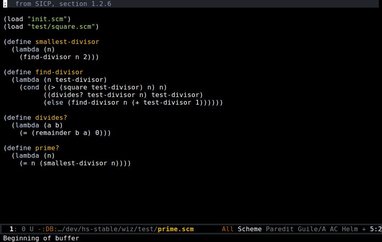Wiz - A Scheme interpreter implemented in Haskell
Table of Contents

Spring 2015, work in progress
Current status
- Showed this project during the Haskell Day in Rome. Received feedbacks which I'm now trying to incorporate.
- Changed internal representation for numbers. Implemented more primitive functions. Fixing eval/apply interaction.
- Implemented the environment model and
let - <2015> Lacking the basic mechanisms to implement closures, the project is simply an implementation of the substitution model.
Todo
There surely are many things yet to be done. Just to name a few:
[ ]proper testing[ ]a certain dose of I/O functions (I'm curious about the changes they will require in the core!)- debugging aids…
define-syntax[X]environment model- lexical binding
[X]let[X]proper packaging
One particular idea I have in mind is to implement some sort of graphical primitives in the language, in order to obtain a system useful to experiment with geometry.
Project log
This log needs some expansion as it does not reflect anymore the current status of the project.
I started this project with a few goals in mind:
- Implement enough Scheme to assist a student following the examples in The Little Schemer
- Understand what's the minimal Scheme core that must be implemented and, on the other hand, how much can be defined in terms of these primitives
- Produce some stylistically sound Haskell code
- Learn more Haskell in the process
There's still work to do for the first three points, but I'm definitely learning a lot.
The implementation
My implementation is still a work in progress but I guess the core won't be subject to radical changes. Code is available on github. Here a quick review of its main parts.
I'm following the design described in Chapter 4 of Structure and Interpretation of Computer Programs. If you're familiar with the book I'm sure you won't find anything new.
Types were the trickiest part to write – at least for me – so I'll start from them.
Types
A Program is a collection of Form:
data Program = Program [Form]
A Form can be either a Definition or an Expression:
data Form = FDef Definition | FExpr Expression deriving (Show)
A Definition binds a Symbol (represented as a String) to an
Expression.
data Definition = Definition String Expression deriving (Show)
Expression are more complex and have many faces:
data Expression = Number Integer | Boolean Bool | Operator Char | Symbol String | Quote Expression | If Expression Expression Expression | Lambda Formals Expression | List [Expression] deriving (Eq)
Eval/Apply
In order to perform something useful we must be able to evaluate a
Form. Evaluation happens in an Environment, which is a mapping
from Symbol to Expression.
data Environment = Environment (Map.Map String Expression) deriving (Eq)
In other words, the Environment tells us what Expression we need
to evaluate to know the value of a Symbol (notice the recursive
nature of this notion).
eval is the only function exported by the Wiz.EvalApply module.
It takes an Environment and a Form, and returns a pair composed by
a possibly new Environment and an Expression representing the
return value of the Form.
eval :: Form -> Environment -> (Environment, Maybe Expression) eval form env = case form of FDef def -> (evalDefinition def env, Nothing) FExpr expr -> (env, Just $ evalExpr env expr)
Evaluating a Definition adds a new mapping in the
Environment. It's the only thing that produces a side-ezffect,
namely a variation in the Environment in which we'll evaluate future
forms.
evalDefinition :: Definition -> Environment -> Environment evalDefinition (Definition symbol expr) (Environment env) = Environment (Map.insert symbol expr env)
Evaluating an Expression yields another simpler Expression, until
we reach an atomic value (so far they are Number, Boolean and
procedures) that we are able to display.
evalExpr :: Environment -> Expression -> Expression
A special case is evaluating a procedure application (e.g. (fact
10)). Assuming fact refers (in the current Environment) to a
procedure, we invoke apply.
apply :: Environment -> Expression -> [Expression] -> Expression
To apply (or invoke) a procedure we must evaluate its body in a new
fabricated enviroment based on the original one but extended with
new symbols. These symbols are the formals parameters of the
procedure, their values are given by the expressions passed as
arguments in the procedure call.
apply env (Lambda (Formals formals) body) arguments = evalExpr env' body where env' = extendEnvironment env (zip formals evaledArguments) extendEnvironment (Environment env) newElems = Environment (Map.union (Map.fromList newElems) env) evaledArguments = map (evalExpr env) arguments
The main loop
After reading some Scheme code in init.scm to initialize the
environment, we enter the main loop (I'm in love with this idea of
building basic language utilities expressed in the language itself).
The main loop is relatively simple. It receives a new form from user
input (I used Haskeline to implement the commandline), it parses it to
obtain an internal representation tree, and it eval it. And so on.
Some thoughts
As I said at the beginning my main goal is to learn: there's plenty of Scheme implementations already, and many are written in Haskell. In that respect designing and writing the interpreter has been so far very rewarding. It's my first "real" Haskell program, and although there are parts I want to reconsider profoundly (the parser implementation is difficult to maintain, aesthetically orrible and in a word suboptimal, to say the least) I am satisfied with the results.
Reasoning about types was difficult at the beginning: I expected that but I didn't foresee all the false starts I had to discard before arriving at something reasonable and working. Now that I'm more proficient I experimented their immense usefulness for refactoring, and generally speaking for reasoning about the program.